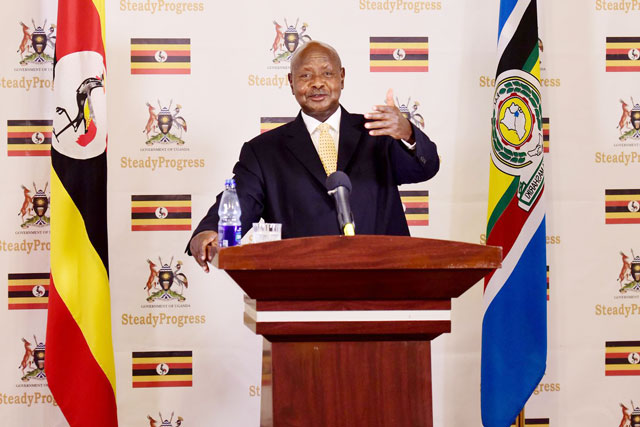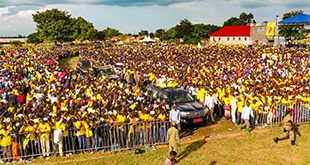
Kampala, Uganda | THE INDEPENDENT | While UMEME recently boasted that they are innovating to reduce operation costs, President Yoweri Museveni has in his New Year’s message said the leading power distributor in the country accounts for 34% of the power distribution cost.
Museveni said UMEME is a key “distorter” in the energy supply chain, stifling government attempts to bring down the cost of power to the end user.
In his message, Museveni said generation, transmission and distribution cost account for only 8% and 11% of electricity supply cost in Ethiopia and Kenya. That means UMEME’s distribution cost quadruples and triples Ethiopia and Kenya transmission and distribution costs respectively.
This contradicts UMEME statement earlier that it has been reducing the cost of serving a customer each year. Umeme had promised regulator, Electricity Regulatory Authority (ERA) that the cost will continue to decline.
UMEME Managing Director Selestino Babung last month stated that they serving Ugandans cheaper than regional peers. He had said that compared to Kenya Power, the government owned electricity supplier in Kenya, UMEME is operating costs are 23 percent lower than they should have been.
“UMEME has been recognised by the World Bank as being one of only two efficient utilities in Sub Sahara Africa,” he said. UMEME says it lowered power losses faster than regional peers.
“In 2011, we were given loss target. It was around 27 percent and Kenya was around 19 percent. Over the period energy losses have reduced by more than 10 percent. As we speak, we are around 16.5 percent,” Babungi said. He argued that the power loss reduction is valued at sh175 billion.
ERA is currently scrutinising UMEME performance parameters for 2019 to 2025. The performance parameter report will come into effect in March 2019. The report sets performance targets which guide UMEME’s investment for the next six years.
When Babungi presented his report last month, he argued that operation costs are largely determined by number of customers and distribution line. For instance, Babungi revealed that they invested average 13 % above what had been approved by the regulator in the 2012-2017 period.
He explained that between 2012 and 2018, they projected to serve one million customer but they were serving 1.3 million customers, an addition of 300,000 customers who were not planned for in the period. Babungi said the network length and energy sales equally exceeded expectations, necessitating extra maintenance costs.
Babungi argued that from 2012-17 the ratio of staff to customers served more than doubled. A staff was serving 377 customers in 2012 but this has increased to 764 in 2019. He said this showcased distinct efficiency.
Babungi further revealed that between 2012 and 2017, the cost of serving a customer almost halved. The cost scaled down from UGX 224,400 to UGX 136,500. He argued that UMEME has been innovating around the consumer.
UMEME innovation, he said yielded dividends; “the prepaid metering alone took off the cost of meter reading, cost of delivering bill, and cost of disconnections which would have been passed on to the consumer. We also went cashless because collecting money is not our business. It also reduced the cost that would have been passed on to the consumer.”
Babungi said the cost for serving a customer is projected to continue reducing to USD 32.7 equivalent to Uganda shilling 121,000 (today’s exchange rate) by 2025 when its concession expire. The company’s future operation costs will be based on number of customers, distribution network length, labour cost, concession area among others factors.
UMEME did not answer questions on the subject in regard to Museveni’s assertion. UMEME media relations manager, Stephen Illungole said they are upcountry undertaking fieldwork.
***
URN
 The Independent Uganda: You get the Truth we Pay the Price
The Independent Uganda: You get the Truth we Pay the Price





which prices have been reduced, when umeme charges a different fee, 3000 every months not for units but for holding that yaka meter in your house, surely I think it would be to their advantage for us to have that meter. what’s wrong with Uganda.
Stephen’s reply that he could not respond to the concerns being raised because he was upcountry, contradicts the ‘efficiency’ point Babungi is raising. Stephen hasn’t got to be physically in the office to attend to clients’ concerns. But yet still, if the cost of doing business almost “halved” why isn’t this cost reduction reflected in the electricity prices? The cost per unit is1,000/=. This is a significant deterrent to investment but also to the ecosystem when peoples only alternative to fuel, becomes cutting trees.
Even when Umeme was directed by government to extend one pole to new customers at no cost,they still insist that Ugandans pay 350000/= for a pole are they not desitoters?
Umeme please help every one and show your cost build out. Other wise it is ridiculous that your are charging consumer’s so much without regard ro economic circumstances.